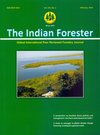Fluctuation of Forest Floor Litter Arthropod Population at Two Tropical Dry Evergreen Forests in India
DOI:
https://doi.org/10.36808/if/2016/v142i2/88773Keywords:
Insect, Litter Arthropod, Arthropod Population, Tropical Forest, India.Abstract
This study aimed to address the population changes in the forest floor litter arthropods of two tropical dry evergreen forests namely Kuzhanthaikuppam (KK) and Oorani (OR) located in India. Arthropod samples from the two forests were collected every month for one-year period. The richness of arthropods (size>3 mm) ranged from 8 to 12 taxa at KK and from 7 to 12 at OR. The density of arthropods fluctuated from 257.8 to 1257.8 ind m-2 at KK and from 266.7 to 1417.8 ind m-2 at OR. Statistical analysis (ANOVA) revealed that the diversity and the density of arthropods fluctuated significantly (P<0.0001) at both the study sites.References
Andersen J.M. and Swift M.J. (1983). Decomposition in tropical forests. In: Tropical rain forest: ecology and management (Sutton, S.L., Whitmore, T.C., Chadwick, A.C. Eds.). Blackwell Scientific, Oxford, UK, pp. 287-309.
Anu A., Sabu T.K. and Vineesh P.J. (2009). Seasonality of litter insects and relationship with rainfall in a wet evergreen forest in south Western Ghats. Journal of Insect Science, 9:1-10.
Ashton P.S. (1990). Thailand: biodiversity center for the tropics of Indo-Burma. Journal of the Science Society Thailand, 16:107-116.
Asprey G.F. and Loveless A.R. (1958). The dry evergreen formation of Jamaica. II. The raised coral beaches of the north coast. Journal of Ecology, 46:547-570.
Barberena-Arias M.F. and Aide T.M. (2003). Variation in species and trophic composition of insect communities in Puerto Rico. Biotropica, 34, 357-367.
Beard J.S. (1944). The natural vegetation of Tobago. Ecological Monograph, 14: 135-163.
Bird S.B., Coulson R.N. and Fisher R.F. (2004). Changes in soil and litter arthropod abundance following tree harvesting and site preparation in a loblolly pine (Pinus taeda L.) plantation. Forest Ecology and Management, 202:195-208.
Brower J., Zar J. and Ende C.V. (1989). Field and laboratory methods for general ecology. Wm. C. Brown Publishers, Dubuque, Iowa, USA.
Burgess N.D., Ponder K.L. and Goddard J. (1999). Surface and leaf-litter arthropods in the coastal forests of Tanzania. African Journal of Ecology, 37:355-365.
Champion H.G. and Seth S.K. (1968). Revised survey of the forest types of India. Manager of Publications, New Delhi.
Dittus W.P.J. (1985). The influence of cyclones on the dry evergreen forest of Sri Lanka. Biotropica, 17:1-14.
Evans H.E. (1984). Insect biology:A textbook of entomology. Addition-Wesley Publishing company, Canada.
Frith D. and Frith C. (1990). Seasonality of litter invertebrate populations in an Australian upland tropical rain forest. Biotropica, 22:181-190.
Hammond P.M. (1992). Species inventory. In: Global biodiversity, status of the Earths living resources (Groombridge, B. ed.). Chapman and Hall, London.
Irmler U. (1982). Litterfall and nitrogen turnover in an Amazonian blackwater inundation forest. Plant Soil, 67: 355-358.
Levings S.C. and Windsor D.M. (1984). Litter moisture content as a determinant of litter arthropod distribution and abundance during the dry season on Barro Colorado Island, Panama. Biotropica, 16:125-131.
Loveless A.R. (1960). The vegetation of Antigua, West Indies. Journal of Ecology, 48:495-527.
Mani S. and Parthasarathy N. (2006). Tree diversity and stand structure in inland and coastal tropical dry evergreen forests of peninsular India. Current Science, 90: 1238-1246.
Morris M.G. (2000). The effects of structure and its dynamics on the ecology and conservation of arthropods in British grasslands. Biological Conservation, 95:129-142.
Nummelin M. (1996). The community structure of arthropods in virgin and managed sites in the Kibale forest, Western Uganda. Tropical Ecology, 37:203-213.
Obrist M.K. and Duelli P. (2010). Rapid biodiversity assessment of arthropods for monitoring average local species richness and related ecosystem services. Biodiversity and Conservation, 19:2201-2220.
Palacios-Vargas J.G., Castano-Meneses G., Gomez-Anaya J.A., Martinez-Yrizar A., Mejia-Recamier B.E. and Martinez-Sanchez J. (2007). Litter and soil arthropods diversity and density in a tropical dry forest ecosystem in Western Mexico. Biodiversity and Conservation, 16:3703-3717.
Parthasarathy N. and Karthikeyan R. (1997). Plant biodiversity inventory and conservation of two tropical dry evergreen forests on the Coromandel coast, south India. Biodiversity and Conservation, 6: 1063-1083.
Persson T. (1989). Role of soil animals C and N mineralization. Plant Soil, 115:241-245.
Perrera N.P. (1975). A physiognomic vegetation map of Sri Lanka (Ceylon). Journal of Biogeography, 2: 185-203.
Pragasan L.A. and Parthasarathy N. (2005). Litter production in tropical dry evergreen forests of south India in relation to season, plant lifeforms and physiognomic groups. Current Science, 88: 1255-1263.
Pragasan L.A. (2013). Litter arthropod population in tropical dry evergreen forests of India. International Journal of Environmental Science, 3:1935-1946.
Reddy M.S. and Parthasarathy N. (2003). Liana diversity and distribution in four tropical dry evergreen forests on the Coromandel coast of south India. Biodiversity and Conservation, 12:1609-1627.
Romoser W.S. and Stoffolano J.G.Jr. (1994). The science of entomology. Brown Publishers, Dubugue, pp.532.
Sayer E.J., Sutcliffe L.M.E., Ross R.I.C. and Tanner E.V.J. (2010). Arthropod abundance and diversity in a lowland tropical forest floor in Panama: the role of habitat space vs. nutrient concentrations. Biotropica, 42:194-200.
Smith I.K. and Vankat J.L. (1992). Dry evergreen forest (coppice) communities of North Andros Island, Bahamas. Bulletin of the Torrey Botanical Club, 119:181-191.
Swift M.J., Heal O.W. and Anderson J.M. (1979). Decomposition in terrestrial ecosystems. Blackwell Scientific, Oxford, UK.
Trapnell C.G. (1959). Ecological results of woodland burning experiments in Northern Rhodesia. Journal of Ecology, 47:129-168.
Downloads
Downloads
Published
How to Cite
Issue
Section
License
Unless otherwise stated, copyright or similar rights in all materials presented on the site, including graphical images, are owned by Indian Forester.





